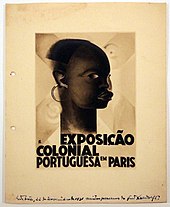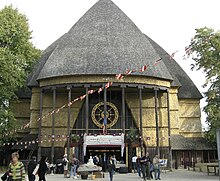


The Paris Colonial Exhibition (or "Exposition coloniale internationale", International Colonial Exhibition) was a six-month colonial exhibition held in Paris, France, in 1931 that attempted to display the diverse cultures and immense resources of France's colonial possessions.
History

The exposition opened on 6 May 1931 in the Bois de Vincennes on the eastern outskirts of Paris. The scale was enormous. It is estimated that from 7 to 9 million visitors came from over the world. The French government brought people from the colonies to Paris and had them create native arts and crafts and perform in grandly scaled reproductions of their native architectural styles such as huts or temples. Other nations participated in the event, including the Netherlands, Belgium, Italy (with a pavilion designed by Armando Brasini), Japan, Portugal, and the United States.
Politically, France hoped the exposition would paint its colonial empire in a beneficial light, showing the mutual exchange of cultures and the benefit of France's efforts overseas. This would thus negate German criticisms that France was "the exploiter of colonial societies the agent of miscegenation and decadence". The exposition highlighted the endemic cultures of the colonies and downplayed French efforts to spread its own language and culture abroad, thus advancing the notion that France was associating with colonised societies, not assimilating them.
The Colonial Exposition provided a forum for the discussion of colonialism in general and of French colonies specifically. French authorities published over 3,000 reports during the six-month period and held over 100 congresses. The exposition served as a vehicle for colonial writers to publicise their works, and it created a market in Paris for various ethnic cuisines, particularly North African and Vietnamese. Filmmakers chose French colonies as the subjects of their works. The Permanent Colonial Museum (today the Cité nationale de l'histoire de l'immigration) opened at the end of the exposition. The colonial service experienced a boost in applications.
26 territories of the empire participated in the Colonial Exposition Issue of postage stamps issued in conjunction with the Exposition.
The Dutch colonial pavilion fire incident

As one of the important colonial powers at that time, the Dutch Empire participated in the Exhibition. The Netherlands presented a cultural synthesis from their colony, the Dutch East Indies (now Indonesia). However, on 28 June 1931, a fire burnt down the Dutch pavilion, along with all cultural objects displayed inside.
Only a few artefacts could be salvaged, including an ancient Javanese bronze Shiva statue, which is now kept in the National Museum of Indonesia. The cause of this massive fire was never identified, and there was speculation at the time that it may have been caused by a short circuit, by flammable building materials that were a fire hazard, or by arsonist sabotage. The material and cultural losses were estimated to be around almost 80 million francs. It was said that the French government paid the Netherlands Indies colonial government for its losses. The money was then used for an expansion of the Bataviaasch Genootschap museum.
Communist counter-exhibition
At the request of the Communist International (Comintern), a smaller counter-exhibition entitled The Truth About the Colonies, organized by the Communist Party and the CGTU, attracted very few visitors (5,000 in 8 months). The first section was dedicated to abuses committed during the colonial conquests, and quoted Albert Londres and André Gide's criticisms of forced labour in the colonies while the second one made a comparison of Soviet "nationalities policy" to "imperialist colonialism".
Posterity
Some of these buildings were preserved or moved:
- Palais de la Porte Dorée, Former-musée national des Arts d'Afrique et d'Océanie, current Cité nationale de l'histoire de l'immigration, porte Dorée in Paris, constructed from 1928 to 1931 by the architects Albert Laprade, Léon Bazin and Léon Jaussely.
- The foundations of the Parc zoologique de Vincennes

- The Pagode de Vincennes, on the edges of the lake Daumesnil, in the former houses of Cameroon and Togo of Louis-Hippolyte Boileau: Photo
- The church Notre-Dame des Missions was moved to Épinay-sur-Seine (95) in 1932.
- The reproduction of Mount Vernon, house of George Washington, moved to Vaucresson where it is still visible.
- The Scenic Railway was moved to Great Yarmouth Pleasure Beach, where it still operates to this day.
See also
Notes

- Leininger-Miller 54–5.
- ^ Leininger-Miller 54.
- The figures often given are 29 to 33 million, but those figures are for entries. Given the sale of many tickets allowing multiple entries, it is estimated that the real number was 8 to 9 million visitors, still an impressive figure. Jean Martin. L'Empire triomphant, 1871- 1936, Vol. 2, Paris, Denöel, 1990, p. 417.
- ^ Leininger-Miller 55.
- TIMES, Special Cable to THE NEW YORK (1931-06-29). "Fire Ruins Dutch Pavilion at French Exhibit; America's Mt. Vernon Endangered but Saved (Published 1931)". The New York Times. ISSN 0362-4331. Retrieved 2021-01-10.
- ^ Endang Sri Hardiati; Nunus Supardi; Trigangga; Ekowati Sundari; Nusi Lisabilla; Ary Indrajanto; Wahyu Ernawati; Budiman; Rini (2014). Trigangga (ed.). Potret Museum Nasional Indonesia, Dulu, Kini dan Akan Datang - Pameran "Potret Museum Nasional Indonesia, Dulu, Kini dan Akan Datang", Museum Nasional Indonesia, 17-24 Mei 2014. Jakarta: National Museum of Indonesia, Directorate General of Culture, Ministry of Education and Culture of the Republic of Indonesia.
- Études coloniales 2006-08-25 "L'Exposition coloniale de 1931 : mythe républicain ou mythe impérial" (in French)
- "The House that Sears Built--in Paris". Sears Homes of Chicagoland. September 28, 2012. Retrieved October 16, 2013.
- "Park History". Great Yarmouth Pleasure Beach, Norfolk. Retrieved 2022-05-02.
References
- Geppert, Alexander C.T., Fleeting Cities. Imperial Expositions in Fin-de-Siècle Europe, Basingstoke/New York: Palgrave Macmillan, 2010. ISBN 978-0-230-22164-2.
- L’Estoile, Benoît de, Le goût des autres : de l'Exposition coloniale aux arts premiers, Paris:Flammarion, 2007.
- Pierre, Michel, L'Exposition coloniale internationale de 1931, Laure Blévis, Hélène Lafont-Couturier, Nanette Jacomijn-Snoep, Claire Zalc, (ed.)1931, Les étrangers au temps de l'Exposition coloniale, Paris, Gallimard, CNHM, 2008, (ISBN 978-2-07-035830-4)
- Leininger-Miller, Theresa A., New Negro Artist in Paris: African American Painters & Sculptors in the City of Light, 1922–1934. Piscataway, New Jersey: Rutgers University Press, 2001.
Further reading
- Morton, Patricia A., Hybrid Modernities: Representation and Architecture at 1931 International Colonial Exposition in Paris. Cambridge, Massachusetts: MIT Press, 2000.
External links
- Journal de l'Exposition coloniale online in Gallica, the digital library of the BnF
- About the reproduction of Mount Vernon built for the exposition
| List of world's fairs in France | |
|---|---|
| Industrial | |
| General |
|
| Specialized |
|
48°49′51″N 2°24′51″E / 48.8307°N 2.4141°E / 48.8307; 2.4141